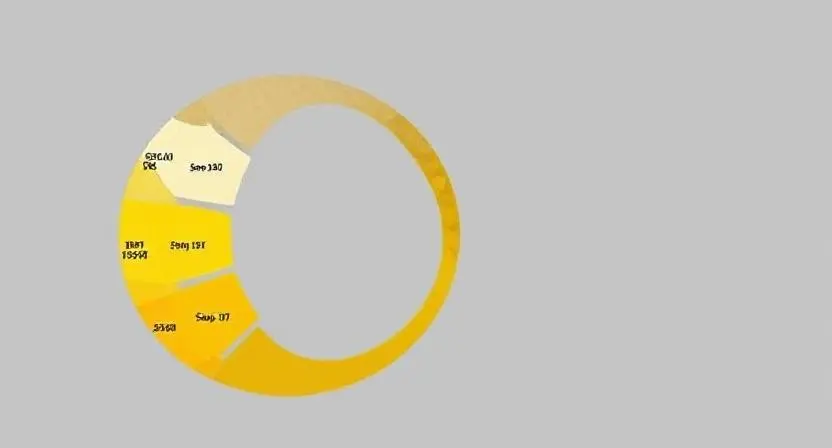Learn about the circle graph above gives the distribution of salad dressing options and what it indicates about our preferred flavors in the circle graph above.
Introduction
Have you ever wondered the circle graph above gives the distribution of salad dressing. The story becomes very interesting when it comes to food, particularly salad dressing!
Consider a vibrant pie chart with slices that each indicate the degree to which people enjoy vinaigrette, ranch, Italian, or Caesar dressings. In addition to displaying our tastes, this image also highlights trends, cultural influences, and patterns in our eating habits.
We’ll examine the circle graph above gives the distribution of salad dressing, its significance, and what it reveals about our taste receptors in detail in this post.
Understanding What a Circle Graph Represents
A pie chart, often known as a circle graph, is a straightforward yet effective tool for displaying the division of a whole into its component pieces. A percentage of overall consumption or preference is shown by each “slice.” When we state that “the circle graph above gives the distribution of salad dressing,” we imply that it shows how people choose or use various kinds of salad dressings.
A broad slice, for example, might reveal that 40% of people favor ranch dressing, 25% prefer Italian dressing, and so forth. It’s similar to quickly observing the “taste balance” of a population.
The circle graph above gives the distribution of salad dressing: The Role of Salad Dressings in Everyday Meals
The circle graph above gives the distribution of salad dressing are more than just garnishes; they provide taste to bland greens. What may otherwise be a boring bowl of lettuce gains personality, flavor, and texture from them. Dressings have a significant impact on how we experience food, whether it’s a creamy ranch for comfort food enthusiasts or a light vinaigrette for health-conscious eaters.
Why Visualizing Salad Dressing Data Matters
“It’s just salad dressing, so why analyze it?” you may ask. However, using a circle graph to visualize data aids in our comprehension of more general eating trends, preferences, and even changes in health. For example, if the graph indicates an increase in low-fat or vinaigrette alternatives, it may indicate that more individuals are becoming health-conscious.
It’s easy to understand these insights because to data visualization!
The Most Popular Salad Dressings Explained
Let’s examine the main players before deciphering the graph. The top participants on the majority of salad dressing distribution circle graphs are:
- Ranch
- Italian
- Caesar
- Vinaigrette
- Honey Mustard
- Thousand Island
- Balsamic
Each has a unique backstory, following, and dietary needs. Let’s examine the main candidates in more detail.
The circle graph above gives the distribution of salad dressing: The All-Time Favorite
On the circle graph above gives the distribution of salad dressing, ranch dressing frequently takes the most portion, sometimes accounting for more than 40% of the total. Its creamy, tangy flavor makes it a popular choice for salads as well as a dip for vegetables, fries, and wings. Ranch dressings are familiar, adaptable, and fulfilling, much like the “comfort blanket” of dressings.
Its balance—not too sour, not too sweet, and just the right amount of creamy—may possibly contribute to its appeal. It seems to be particularly popular with Americans.
The circle graph above gives the distribution of salad dressing: A Zesty Classic
At the circle graph above gives the distribution of salad dressing, Italian dressing comes next on the list, frequently accounting for 20–25% of the circle graph. It is the preferred option for people who like a lighter, zestier flavor because of its lush herbs and tart vinegar-and-oil base. It’s ideal for fresh garden mixtures or pasta salads.
The “Mediterranean” aspect of salad culture is embodied by Italian dressing, which is tasty but light and full of herbs and olive oil to promote a balanced diet.
The circle graph above gives the distribution of salad dressing: Rich, Creamy, and Timeless
Strong-tasting people have a special spot for Caesar dressing. It’s rich and powerful, made with anchovies, garlic, lemon juice, and Parmesan cheese. Even though it often only makes up 15% of the circular graph, it’s a popular option for those who like gourmet salads.
It is the “fine dining” of dresses; it is always gratifying despite being a bit ostentatious and decadent.
The circle graph above gives the distribution of salad dressing: The Healthy Choice
At the circle graph above gives the distribution of salad dressing, Vinaigrette dressings are becoming increasingly popular as more people search for healthier options. Light, refreshing, and lower in calories, they are made from oil and vinegar (sometimes with fruit or herb aromas added).
Vinaigrette is steadily gaining popularity, which indicates a trend toward mindful eating and nutrition awareness, according to a circle graph that displays the distribution of salad dressings.
Honey Mustard and Other Rising Stars
In addition to the traditional flavors, new ones are always appearing; avocado-based dressings, honey mustard, and balsamic are becoming popular. Though they typically appear as smaller slices on the circle graph, these flavors stand for variety and innovation in contemporary diets.
The pie chart’s tiny but vibrant slices serve as a reminder that variety in taste is equally as significant as tradition.
How the Circle Graph Reveals Consumer Trends
It is evident from interpreting the circle graph that dietary habits reflect both social and health trends. For instance:
- A larger slice for vinaigrette may indicate health awareness.
- A dominant Ranch section could reflect comfort-food cravings.
- Growth in new flavors like balsamic shows a taste for experimentation.
The the circle graph above gives the distribution of salad dressing is beautiful because it conveys a narrative about people’s habits, decisions, and changing lives in addition to numbers.
Cultural and Regional Preferences
Regional tastes for salad dressings might differ significantly. Ranch is the rule in the United States. Olive oil and balsamic vinaigrettes are more prevalent in Mediterranean nations. Sesame-based dressings are popular in Japan.
A interesting cultural tapestry of taste preferences would emerge from comparing circle graphs from many regions of the world.
It serves as a reminder that although salads are a universal food, our taste preferences are influenced by our upbringing and surroundings.
What Businesses Learn from This Graph
Graphs like this are closely watched by food companies. They make greater investments in new ranch varieties—perhaps low-fat or spicy—when they observe Ranch prevailing. They may add other flavors to their lineup if vinaigrettes are popular.
In summary, the distribution of salad dressing in the circle graph above aids food brands in determining where to market and where to innovate.
Health Trends Reflected in Salad Dressing Choices
The graph can also show how our decisions are influenced by health consciousness. Lighter and more natural dressings have gained popularity during the last ten years. Consumers are choosing organic or sugar-free products, reading labels, and keeping an eye on their caloric intake.
This tendency is evident in the declining popularity of creamy, high-fat dressings and the increasing popularity of vinaigrettes and plant-based substitutes.
The circle graph above gives the distribution of salad dressing: The Psychology Behind Dressing Selection
Why do we select particular dressings? It involves more than just taste; it also involves personality and mood. According to psychologists,
- Creamy dressing lovers may seek comfort and familiarity.
- Vinaigrette fans may enjoy adventure and freshness.
- Spicy dressing enthusiasts often love excitement and variety.
So, your favorite salad dressing might actually say something about you!
FAQs
- What does the circle graph above give?
Customers’ preferences for several types of salad dressing, such as ranch, Italian, and vinaigrette, are displayed in the circle graph above.
- Which salad dressing is most popular?
In many surveys, ranch dressing is the most popular dressing since it usually occupies the biggest section of the circle graph.
- Why is data visualization important in food studies?
It enables researchers and businesses to swiftly comprehend patterns, such as shifting consumer preferences or an increase in the desire for healthier products.
- How does culture influence the circle graph above gives the distribution of salad dressing choices?
Our taste buds are shaped by cultural customs; Americans tend to like creamy dressings, whereas Mediterranean countries favor those based on olive oil.
- What can we learn from the salad dressing distribution graph?
It reveals how our diets change over time and educates us about consumer behavior, health trends, and flavor preferences.
Conclusion
The circle graph above gives the distribution of salad dressing may initially appear to be a straightforward illustration of salad dressing preferences. However, if you look more closely, you’ll notice that it reflects innovation, culture, health, and individual preference. It teaches us that even something as commonplace as salad dressing relates to more universal human narratives—our routines, our cravings, and our quest for taste.
Therefore, keep in mind that you are also a member of that vibrant circle the next time you garnish your salad.

















Leave a comment